iPhone 13 Pro vs iPhone 13: A Dimension Comparison
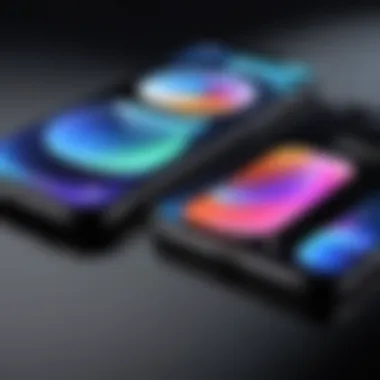
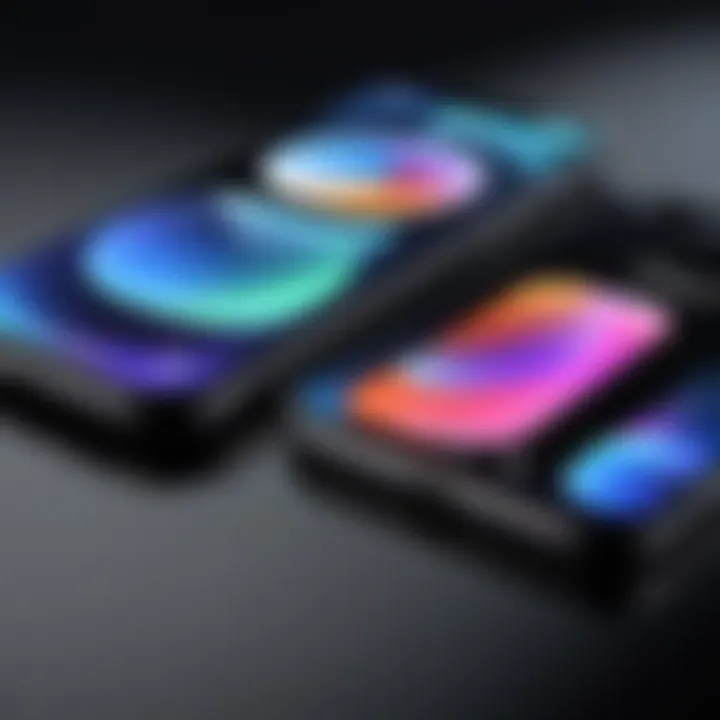
Intro
In the realm of smartphones, Apple's iPhone lineup consistently garners significant attention. The iPhone 13 and iPhone 13 Pro, both unveiled in 2021, represent the pinnacle of modern mobile design. With their advanced features, both models attract distinct segments of users. However, a crucial consideration for many potential buyers is understanding how these devices differ in their dimensions.
This comparative analysis will delve into the dimensions of both the iPhone 13 and the iPhone 13 Pro. By doing so, it aims to clarify key aspects such as usability, weight, and overall ergonomics. Such insights will serve both tech enthusiasts seeking detail and casual consumers looking to make a well-informed choice.
Key Features
Design and Build Quality
The design philosophy of Apple has long prioritized aesthetic appeal alongside functionality. The iPhone 13 Pro is slightly larger and heavier than the iPhone 13, which can influence user experience.
- Iphone 13: 146.7 x 71.5 x 7.65 mm, weight: 174g
- Iphone 13 Pro: 146.7 x 71.5 x 7.65 mm, weight: 203g
Despite identical height and width, the Pro version's additional materials and features contribute to its heft. The iPhone 13 Pro has a stainless steel frame, which adds to weight compared to the aluminum used in iPhone 13. This gives the Pro a more premium feel, but may affect comfort during prolonged use.
Display and Performance
Display is a pivotal element for smartphones, as it directly influences user interaction.
- The iPhone 13 features a 6.1-inch Super Retina XDR display, supporting HDR10 and Dolby Vision.
- The iPhone 13 Pro also has a 6.1-inch Super Retina XDR display, but it offers ProMotion technology, enabling refresh rates up to 120Hz.
Both models exhibit impressive color accuracy and brightness. However, the Pro model's enhanced refresh rate leads to smoother animations and improved responsiveness, particularly relevant for gamers and content creators.
"The differences in dimensions between the iPhone 13 and iPhone 13 Pro may seem subtle but can significantly influence user experience and choices."
Product Specifications
Technical Specifications
It's important to highlight the technical specifications that accompany the dimensions in evaluating usability. While both models utilize the A15 Bionic chip, the Pro model includes a 5-core GPU, enhancing graphics performance, particularly for demanding applications.
- Iphone 13: 4-core GPU, suitable for general use.
- Iphone 13 Pro: 5-core GPU, optimized for gaming and intensive tasks.
Compatibility and Connectivity
Both models share similar compatibility with iOS ecosystems, making them suitable for the same software and accessories. Connectivity options, including 5G support, are available in both devices.
In summary, understanding the differences in dimension and design between the iPhone 13 and iPhone 13 Pro extends beyond mere numbers. The implications for usability, combined with their specifications, equip consumers with knowledge to make educated decisions in their smartphone purchase.
Intro to iPhone Models
In the realm of smartphones, Apple has carved a distinct niche with its iPhone lineup. Understanding the nuances of various iPhone models, such as the iPhone 13 and its Pro variant, is essential for consumers and tech enthusiasts alike. This section serves as an introduction to the iPhone 13 series, which includes innovative features and improved hardware specifications.
The importance of discussing iPhone models lies in how they position Apple in the competitive market and how they resonate with user needs. The iPhone 13 and iPhone 13 Pro are not merely iterations of their predecessors; they incorporate advancements that address previous shortcomings while introducing features that enhance functionality and user experience.
When selecting between models, considerations such as dimensions, weight, ergonomic design, and usability come into play. Buyers must weigh these factors against their personal preferences, making the dimensions analysis crucial. The decisions made at this stage can significantly affect everyday usage, such as grip comfort and portability.
By dissecting the dimensions and comparing them closely, this article aims to illuminate the differences and help potential buyers navigate through their choices effectively. Insights drawn from this comparative approach will equip readers with the knowledge necessary for making informed decisions and understanding how these devices fit into their lives.
Overview of iPhone Series
The iPhone 13 series, launched in September 2021, represents Apple's ongoing commitment to innovation and excellence in smartphone technology. It includes four variants: the iPhone 13 mini, iPhone 13, iPhone 13 Pro, and iPhone 13 Pro Max. Each model has been designed to cater to different user needs while retaining a cohesive aesthetic and functionality.
The iPhone 13 focuses on providing a balance of performance and affordability for everyday users. It includes the A15 Bionic chip, a dual-camera system, and significant improvements in battery life compared to the iPhone 12.
On the other hand, the iPhone 13 Pro targets those who seek advanced features. With a triple-camera system, ProMotion display, and superior materials, it is tailored for users interested in photography and graphics-intensive applications.
Both models retain a striking design with a ceramic shield front cover and sleek glass back, ensuring durability alongside aesthetics. The dimensions of these models become a crucial factor that affects not only style but practical usability in day-to-day scenarios.
Positioning of iPhone Pro and iPhone
The positioning of the iPhone 13 Pro and iPhone 13 highlights their differing target audiences and usage scenarios. While both share the same core technology and iOS experience, they diverge significantly in functionality and application.
The iPhone 13 is well-positioned as an excellent all-around device. It's suitable for the broad spectrum of casual users who prioritize basic smartphone functionality and a good balance of features. The dimensions are user-friendly, making it easy to hold and use single-handedly.
In contrast, the iPhone 13 Pro is geared towards professionals, creators, and tech-savvy individuals who demand more from their devices. It emphasizes advanced features and builds quality over more standard needs. The additional weight and dimensions of the Pro model cater to those who may want a larger display for enhanced visual experiences, such as gaming or media consumption.
The choice between these two models ultimately hinges on the user's expectations and how they intend to utilize the device. Understanding these positions within the context of dimensions influences buying decisions and sets the stage for a deeper dive into their specifications.
Physical Specifications
The physical specifications of a smartphone, particularly its dimensions, play a vital role in the overall user experience. They determine how the device feels in hand, how it fits in pockets, and even how it performs regarding usability and functionality. Understanding the nuances of these specifications helps consumers make informed decisions when choosing between models. This section delves into the dimensions of both the iPhone 13 Pro and the iPhone 13, focusing on how these attributes contribute to each device's appeal and usability.
Dimensions of iPhone Pro
Height
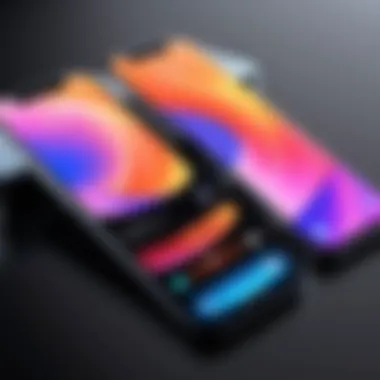
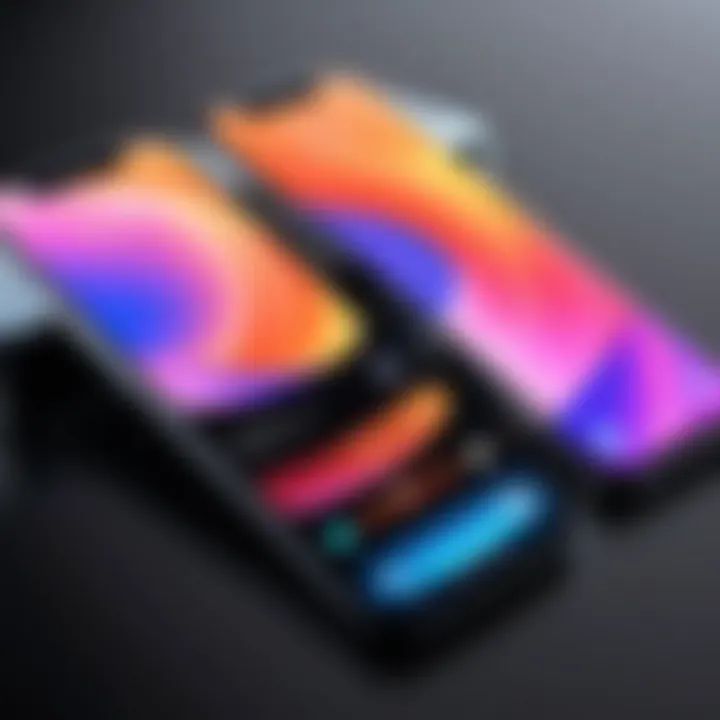
The height of the iPhone 13 Pro is 146.7 mm. This specific dimension offers a relatively tall design, contributing to an immersive display experience. A taller phone helps in better readability, allowing more content to be shown on the screen simultaneously. Users often prefer a height that enhances usability without feeling cumbersome. The key characteristic of this height is that it aligns well with many users' habits, making it a popular choice for those who often use their phones for reading or browsing.
An advantage of this height is the comfortable grip when holding the phone with one hand. However, it may present disadvantages for users with smaller hands, as reaching across the screen can be tricky.
Width
With a width of 71.5 mm, the iPhone 13 Pro's width is another contributing factor to its ergonomic design. This width is designed to ensure that the device remains sleek yet functional. It allows for easy navigation, especially when using gestures common in iOS.
A narrower width also contributes to a sophisticated appearance. Many consumers see this characteristic as beneficial because it does not compromise the screen size while still being easy to handle. The slim design may not be for everyone, though; some users may find it less comfortable to grip securely.
Thickness
The iPhone 13 Pro has a thickness of 7.65 mm. This slim profile is quite appealing as it adds to the device's modern aesthetic. A thinner device often feels lighter and can be more comfortable to carry.
However, a thinner design has its downsides. It could potentially lead to concerns about durability. Users may prefer a thicker phone if they prioritize sturdiness over lightweight feel. Thus, while this thickness is popular, it is not without considerations regarding its long-term resilience.
Dimensions of iPhone
Height
The iPhone 13 features a height of 146.7 mm, identical to that of the iPhone 13 Pro. This shared height suggests a similar user experience regarding readability and display utilization. This identical dimension aims to cater both to consumers choosing the Pro version and those selecting the standard model.
Although shared height can be advantageous, some users may expect distinct design traits signifying a higher-tier model. Thus, while this height works well, the similarities could lead to issues in how the devices are perceived.
Width
The iPhone 13 has a width of 71.5 mm, also matching the iPhone 13 Pro. As with the Pro version, this dimension is crucial for user interaction. Users benefit from a consistent experience in terms of navigation and reach.
The realization that both models have this dimension signifies Apple's approach to standardizing user experiences across its line. However, this may create moments of confusion among buyers, who might anticipate more differences based on their version choice.
Thickness
The iPhone 13's thickness is slightly more than the Pro at 7.65 mm. This difference, while minor, can impact the perception of quality and durability among users. A thicker design can give the impression of sturdiness, thus making it appealing to users who prioritize long-lasting devices.
While this thickness may enhance durability, it could also lead to a heavier feel. Users sensitive to weight might prefer the slimmer build of the iPhone 13 Pro. Therefore, this slight variation plays a role in how each device is ultimately perceived.
Weight Comparison
In the context of smartphone design, weight remains a critical factor that can significantly influence user experience. When people choose between devices, they often prioritize factors such as portability and comfort. A lightweight phone is usually easier to handle and carry, while a heavier model might offer a perception of durability or premium quality. In this segment, we shall analyze the weights of the iPhone 13 Pro and iPhone 13, highlighting how this aspect can affect usability and overall satisfaction.
Weight of iPhone Pro
The iPhone 13 Pro weighs approximately 204 grams. This weight may seem considerable; however, it fits well within the category of premium smartphones. The weight is attributed to the materials used and the advanced features incorporated, including a high-resolution camera system and a robust battery.
The additional weight does not compromise the usability for most users. Many find the heft reassuring, providing a sense of stability when held. Nonetheless, for individuals who prioritize lightweight devices, this might be a slight drawback.
Weight of iPhone
In contrast, the iPhone 13 has a weight of around 173 grams. This makes it noticeably lighter than the Pro variant. The difference in weight can notably enhance the user experience, especially for those who frequently use their phones for extended periods. A lighter device can reduce fatigue during repetitive tasks such as texting, browsing, or gaming.
"The choice of smartphone often hinges on comfort and ease of handling, making weight a vital component in the decision process."
The iPhone 13 appeals to consumers looking for a capable and lighter option, while the iPhone 13 Pro caters to users who seek advanced features and solid build construction, even at the expense of a few extra grams.
Screen Size and Quality
Understanding screen size and quality is vital when comparing the iPhone 13 Pro and iPhone 13. These elements significantly affect user experience, impacting multimedia consumption, gaming, and daily tasks. A larger screen might offer a better viewing experience, while display quality can influence visual clarity, color accuracy, and overall satisfaction.
With advances in technology, consumers now expect high-performance displays that not only look good but also provide durability and exceptional functionality. In this section, we analyze the features of both models to comprehend how they meet these expectations.
Display Features of iPhone Pro
The iPhone 13 Pro is equipped with a 6.1-inch Super Retina XDR display. This OLED panel supports a resolution of 2532 x 1170 pixels, enabling it to deliver crisp and clear visuals. One notable feature is the ProMotion technology, which allows for an adaptive refresh rate of up to 120Hz. This means smoother scrolling and more responsive touch inputs, enhancing the overall user experience.
The brightness of the display is also impressive, reaching up to 1000 nits for standard content and 1200 nits for HDR content. This brightness level makes it easier to view content in bright outdoor conditions. Additionally, the color accuracy of the display has been optimized to enhance images and graphics, making it a preferred choice for photographers and creatives.
To complement these features, the display is protected by Ceramic Shield, which offers increased durability and resistance to scratches. This ensures that the phone can withstand everyday usage without compromising display integrity.
Display Features of iPhone
In contrast, the iPhone 13 features a 6.1-inch Super Retina XDR display as well. However, while it shares the same resolution of 2532 x 1170 pixels, it does not incorporates ProMotion technology, resulting in a fixed refresh rate of 60Hz. Although this still provides a good viewing experience, it may not feel as smooth during interactions as the iPhone 13 Pro.
The brightness of the iPhone 13 display also reaches up to 800 nits for standard content and 1200 nits for HDR, which is commendable but falls short of the Pro model. This difference might be noticeable for users who often view their screens in bright environments.
Both models support HDR content, enhancing the viewing experience for movies and videos. However, the iPhone 13, while offering solid performance, lacks some advanced features found in the Pro, which can be crucial for users who prioritize display quality in their daily tasks.
"The display is the main point of interaction with the device, making its quality crucial for user satisfaction across all applications."
In summary, while both the iPhone 13 Pro and iPhone 13 come with similar display sizes and basic qualities, the Pro model offers advanced features that cater more to high-end users. The choice ultimately depends on individual needs and how one prioritizes screen technology in their daily activities.
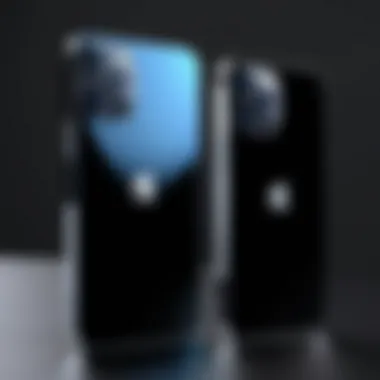
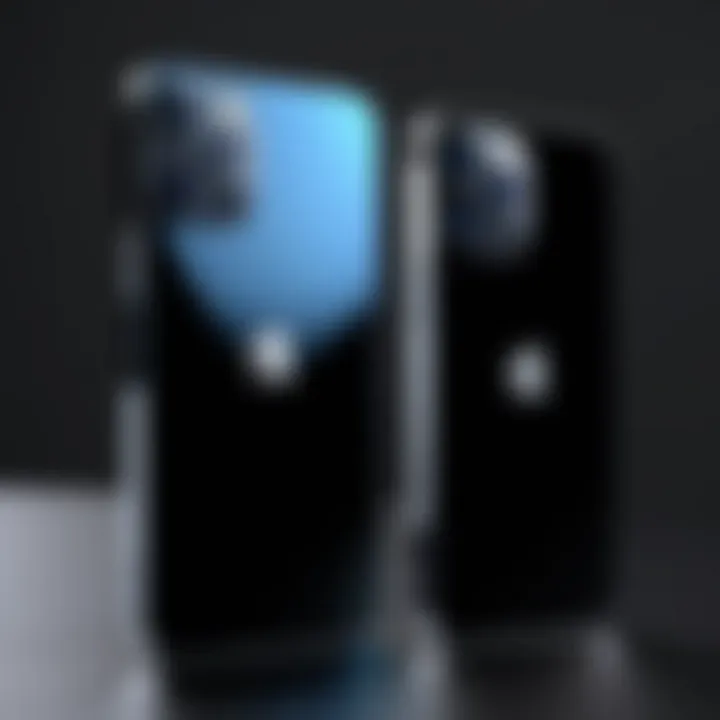
Design Variations
The design variations between the iPhone 13 Pro and iPhone 13 are noteworthy. They reflect more than just aesthetic choices; they signify brand identity, user preferences, and technological advancement. Understanding these variations helps consumers make informed decisions, especially when selecting a device that aligns with their needs and lifestyle.
Materials Used in iPhone Pro
The iPhone 13 Pro is crafted using premium materials that enhance both its durability and aesthetics. The frame is made from surgical-grade stainless steel, which is not only strong but also has a polished finish that gives it a luxurious feel. The glass back is made of Ceramic Shield, which Apple claims offers four times better drop performance compared to previous models. This combination results in a device that is robust and visually appealing, appealing to those who value high-end materials.
In terms of weight, the design of the iPhone 13 Pro leads to a heftier feel in the hand, suggesting quality and reliability as many users appreciate the tangible nature of their gadgets. Overall, the choice of materials demonstrates Apple's commitment to maintaining a premium experience for its users, balancing form and function effectively.
Materials Used in iPhone
The iPhone 13, on the other hand, opts for an aluminum frame, which while less expensive to produce, still ensures a decent level of durability. The back is also glass, albeit with a different formulation compared to the Ceramic Shield of the Pro model. This choice makes the iPhone 13 lighter and more accessible. Users may experience a slightly lower drop resistance when compared to the iPhone 13 Pro, but the overall feel is still solid and dependable.
The iPhone 13's choice of materials offers a balance between affordability and performance. It caters to consumers who want a reliable device without the high price tag. While the materials may not carry the same prestige as the Pro model, they still meet the essential standards of quality expected from Apple devices.
Understanding the differences in materials enhances appreciation for each model's unique identity, as well as informs consumer choices.
User Ergonomics
User ergonomics plays a crucial role when choosing a smartphone, particularly when comparing models like the iPhone 13 Pro and the iPhone 13. Proper user ergonomics refers to how well a device fits into the hands of its users, impacting comfort, ease of use, and overall satisfaction. This aspect can significantly influence a user's daily interaction with the device, from simple tasks like texting to more complex operations like gaming or multitasking. Understanding the ergonomic factors surrounding grip and handling aids consumers in making informed decisions that align with their preferences.
A device that is easy to hold and operate can reduce fatigue and strain during prolonged usage. Consequently, both weight and dimensions are pivotal in enhancing the ergonomic experience. The focus on user ergonomics helps not only to highlight the key differences between the iPhone 13 Pro and 13 but also to underscore the significance of a comfortable smartphone in today’s fast-paced digital environment.
Grip and Handling of iPhone Pro
The iPhone 13 Pro boasts specific dimensions and weight that influence how it feels in the hand. With a height of 5.78 inches, a width of 2.82 inches, and a thickness of 0.30 inches, the device is relatively compact but still maintains a premium feel. The materials used in the iPhone 13 Pro, like surgical-grade stainless steel, contribute to its solid and heavy feel. This gives users a distinct sensation of quality.
In terms of grip, the flat edges combined with subtle curves provide a comfortable hold. Users often report that the phone feels secure when held in one hand, which is essential for actions like taking photos or scrolling. However, the added weight may require a slight adjustment for those accustomed to lighter models. All in all, the iPhone 13 Pro is designed to enhance handling without compromising aesthetics.
Grip and Handling of iPhone
The iPhone 13 has slightly different dimensions, standing at 5.78 inches tall, 2.82 inches wide, and with the same thickness as the Pro version. Its weight is comparatively lighter than the Pro, making it easier to handle for extended periods. This can appeal to users who prioritize comfort over premium materials.
The rounded edges of the iPhone 13 create a soft feel in the hand, which tends to be more forgiving for various grip styles. Users can easily maneuver the phone while performing everyday tasks, such as browsing or messaging. However, the smooth surfaces might make it less secure for some users, especially if they are multitasking. Over time, the grip experience can affect how consumers perceive the overall value and usability of the iPhone 13.
Camera System and Integration
The camera systems in smartphones are often pivotal in the decision-making process for potential buyers. In the context of the iPhone 13 Pro and iPhone 13, their camera functionalities significantly influence user experience and satisfaction. This analysis focuses on how the distinct camera specifications and integrations enhance usability and overall performance.
A smartphone's camera plays critical roles in capturing moments, from casual photos to professional-grade images. For photography enthusiasts, having advanced features can be a decisive factor. Both models boast impressive camera systems, but the Pro variant offers enhancements that might sway users seeking higher quality.
Understanding each device's camera specifications helps consumers make informed choices. Users often consider not only the resolution and number of lenses but also features like low-light performance, image stabilization, and additional capabilities such as ProRAW or Night mode. These elements are essential, as they affect how well one can take pictures in various environments.
Camera Specifications of iPhone Pro
The iPhone 13 Pro is equipped with an advanced triple-camera system. This includes a 12MP Ultra Wide camera, a 12MP Wide camera, and a 12MP Telephoto camera.
- Ultra Wide Lens: With a 120-degree field of view, this lens allows users to capture expansive landscapes or group photos effectively.
- Wide Lens: The main lens excels in low-light conditions thanks to its large aperture, providing excellent clarity and detail in dim settings.
- Telephoto Lens: This lens brings subjects closer, offering 3x optical zoom, which is useful for portrait shots without compromising image quality.
Additional features of the iPhone 13 Pro's camera system include:
- ProRAW and ProRes video capabilities, which allow for greater editing flexibility.
- Night mode across all lenses enhances photos taken in low-light environments.
- Cinematic mode provides depth-of-field adjustments while recording video, giving a professional feel to casual recordings.
Camera Specifications of iPhone
The iPhone 13 features a dual-camera system, comprising a 12MP Ultra Wide camera and a 12MP Wide camera. This setup also provides users with robust photographic capabilities, albeit with fewer advanced features than the Pro model.
- Ultra Wide Lens: Similar to the Pro, it offers a wide field of view allowing for dynamic compositions.
- Wide Lens: Although it lacks the low-light superiority of the Pro's lens, it still performs admirably in various conditions.
Key functionalities of the iPhone 13's camera include:
- Night mode for improved low-light performance, though less effective compared to the iPhone 13 Pro.
- Photographic Styles: This feature allows users to customize the tone and color of their images directly through the camera app.
- Cinematic mode is present, but with fewer adjustments than that of the Pro, making it great for casual use but limited for more serious videography.
Software and Features
Understanding the software and features of a smartphone like the iPhone 13 Pro and iPhone 13 is crucial for any potential buyer. The operating system significantly influences the overall user experience, performance, and functionality of the device. Apple’s iOS is known for its seamless integration with hardware, providing a smooth and efficient interface. The differences in features between the two models can affect usability, software support, and how well the device meets user needs.
Both models run on iOS, but the capabilities can vary based on their specifications. Software updates are another critical factor. Users must consider how long the device will receive updates and new features. This can influence the resale value of the device and ensure users can access the latest functionality.
Operating System of iPhone Pro
The iPhone 13 Pro operates on the latest version of iOS, benefiting from features designed for high-performance tasks and advanced applications. The ProMotion display, exclusive to the Pro model, enhances the responsiveness of the user interface. This feature allows for a dynamic refresh rate up to 120Hz, which makes for a smoother scrolling experience and more fluid animations. Additionally, the iPhone 13 Pro offers features like Cinematic Mode, allowing users to make professional-quality videos with automatic focus transitions.
The iPhone 13 Pro's operating system also includes enhanced computational photography capabilities, leveraging its A15 Bionic chip. This chip aids in real-time image processing and provides advanced machine learning tasks, improving overall camera performance. This means users can enjoy better low-light photography and faster processing for tasks such as editing.
Operating System of iPhone
On the other hand, the iPhone 13 runs the same version of iOS, yet it lacks some features found in the Pro variant. This model does not have the ProMotion display, maintaining a standard 60Hz refresh rate. While still offering a smooth experience, it may not feel as fluid during fast interactions. Nonetheless, it supports features like Night Mode and Smart HDR, which are sufficient for average users who prioritize photography.
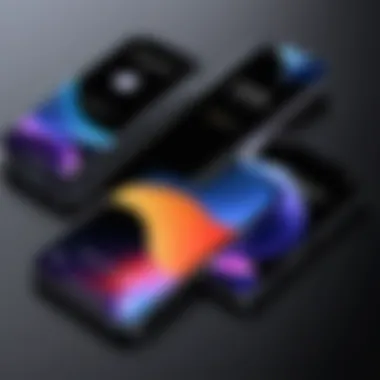

The differences in processing power may be noticeable in high-demand situations. The A15 Bionic chip in the iPhone 13 can handle daily tasks effortlessly but may fall short in hardcore multitasking or heavy gaming compared to the Pro variant. For most consumers, the iPhone 13 provides ample software support, and it receives all significant iOS updates, keeping pace with modern features.
Battery Life and Performance
Battery life and performance are critical elements when comparing smartphones, particularly flagship models like the iPhone 13 Pro and iPhone 13. Users increasingly depend on smartphones for various tasks, and having sufficient battery life ensures that devices function without interruption. Assessing battery performance involves more than just capacity; it includes how well the device manages power under different workloads and user interactions. Efficient battery use can significantly enhance the user experience, especially for those who engage heavily with applications, games, and multimedia.
Battery Specifications of iPhone Pro
The iPhone 13 Pro boasts impressive battery specifications, which contribute to its overall performance. With a capacity of approximately 3095 mAh, this model supports up to 22 hours of talk time and up to 75 hours of audio playback. The device also features Apple's advanced battery management system. This technology optimizes battery performance, potentially extending battery life even further.
Another notable aspect is the fast charging capability. It can reach up to 50% charge in around 30 minutes when using a compatible charger. There is also support for wireless charging, including MagSafe technology, that allows for easy attachment of compatible accessories. This convenience makes it great for dynamic environments where quick charging is advantageous.
Battery Specifications of iPhone
The iPhone 13 offers competitive battery specifications as well, housing a 3240 mAh battery. This model is designed to excel in everyday usage with up to 19 hours of talk time and around 75 hours of audio playback similar to its Pro counterpart.
When used effectively, the iPhone 13 provides sufficient battery life for most users. It also supports 20W fast charging, facilitating a half charge in approximately 30 minutes under optimal conditions. Wireless charging capabilities, such as MagSafe, are also available to enhance usability.
Pricing and Value Considerations
Pricing is an essential aspect when evaluating technology products, such as the iPhone 13 Pro and iPhone 13. Consumers often make decisions based on their budget and the perceived value offered by each device. A well-rounded understanding of cost can inform buyers about which phone to choose based on their needs and preferences. This comparison goes beyond just the price tag; it includes factors like features, brand reputation, and long-term investment value.
When discussing pricing, it is crucial to highlight how different pricing structures can influence consumer choices. The cost of a device should correlate to its unique selling points and functionality. This section aims to explore the monetary considerations associated with both models while shedding light on the broader implications of each device's value.
Cost of iPhone Pro
The iPhone 13 Pro is positioned as a premium offering within the iPhone lineup. As of its launch, the starting price typically begins higher than its counterpart, the iPhone 13. This elevated cost reflects several advanced features, including an upgraded camera system, superior display technology with ProMotion, and more robust materials. Each of these elements contributes significantly to the overall user experience.
For potential buyers, evaluating whether the incremental benefits justify the price point of the iPhone 13 Pro is essential. Features such as additional storage options and enhanced processing power create a compelling case for those who prioritize premium functionality. Here’s a quick overview:
- Starting Price: Higher than iPhone 13
- Enhanced Features: Superior camera and display
- Value Proposition: Ideal for power users and photography enthusiasts
Understanding the cost structure allows consumers to reflect on how their personal usage aligns with these advanced features.
Cost of iPhone
In contrast, the iPhone 13 comes at a more accessible price point. This model offers an excellent balance of features and performance while maintaining a more budget-friendly approach. For many users, the iPhone 13 adequately meets daily needs without delving into the higher-end functionalities present in the Pro variant.
The price of the iPhone 13 typically represents a solid investment for users who desire a reliable smartphone without the premium price of the Pro model. Here are some key aspects:
- Starting Price: More affordable than iPhone 13 Pro
- Core Features: Solid camera performance and satisfactory battery life
- Value Proposition: Suitable for everyday users and general consumers
Assessing the cost of both models aids consumers in making informed decisions aligned with their budgets and needs.
"A product's price tag is only part of the story; understanding its context within one's lifestyle is key to making an informed choice."
User Preferences and Market Trends
User preferences and market trends play a significant role in shaping the success of smartphone models, particularly for luxury brands like Apple. Understanding these elements offers important insights into consumer behavior and helps identify what features are prioritized by the target audience. In the case of the iPhone 13 Pro and iPhone 13, there are noticeable distinctions based on consumer preferences that stem from both functional and aesthetic desires.
Consumer Preferences for iPhone Pro
The iPhone 13 Pro attracts consumers who seek advanced features and superior performance. Many of these users prioritize a better camera system, as the Pro model offers enhanced photographic capabilities. For instance, the Pro's larger aperture and improved night mode attract photography enthusiasts and professionals alike. Additionally, users interested in mobile gaming appreciate the Pro's higher refresh rate display and enhanced graphics performance.
Another important aspect is the material quality. The iPhone 13 Pro uses surgical-grade stainless steel and a textured matte glass back which appeals to those valuing durability and premium design. Users often feel that the additional expenditure for the Pro model is justified by these superior specs and materials. They consider the iPhone 13 Pro not just a phone but a lifestyle accessory that reflects their taste and status.
Consumer Preferences for iPhone
Conversely, the standard iPhone 13 caters to a broader audience. This model appeals primarily to those who desire a solid smartphone experience without the extra luxury features. Many consumers may not need the advanced camera options or the high-refresh-rate display offered in the Pro version. Instead, they prioritize reliability and value for money, which the iPhone 13 delivers effectively.
This model is lighter and more compact, which can be advantageous for users who prioritize portability. The iPhone 13, with its vibrant colors and solid build, attracts casual users who appreciate a stylish yet functional smartphone. The price point also makes it a more attractive option for those on a budget or for families looking to purchase multiple devices.
In summary, preferences diverge between those who value high-end specifications and materials and those who seek a balanced, functional device. Understanding these trends and preferences can significantly impact consumer decision-making and highlight the distinctions between the iPhone 13 Pro and iPhone 13.
Culmination and Recommendations
In this final section, the comparative analysis of the iPhone 13 Pro and the iPhone 13 culminates in a discussion of key takeaways and recommendations for potential buyers. Understanding the dimensions of these devices is crucial for making an informed choice. Each aspect, from size to weight, impacts usability and user experience.
The iPhone 13 Pro is slightly heavier and thicker, which may appeal to users desiring a more substantial feel in their devices. In contrast, the iPhone 13 offers a lighter and slightly slimmer profile, which can enhance portability. Evaluating these differences is essential for consumers who prioritize comfort and usability based on their lifestyle.
Additionally, the decision should not be based solely on size. Other factors including screen quality, camera capabilities, and price all intertwine with the dimensions to influence overall satisfaction. An informed decision takes into account how these dimensions affect everyday use, providing benefits or presenting challenges.
Ultimately, potential buyers should consider their own preferences and needs when deciding between these two models.
Summary of Key Differences
- Dimensions: The iPhone 13 Pro measures 146.7mm in height, 71.5mm in width, and 7.65mm in thickness. The iPhone 13, however, has the same height and width but is slightly thicker at 7.65mm.
- Weight: The iPhone 13 Pro weighs 204 grams while the iPhone 13 is lighter, coming in at 173 grams. This makes a difference for users who frequently hold their devices for extended periods.
"The choice between the iPhone 13 Pro and iPhone 13 hinges on specific user needs and preferences, reflecting how product design resonates with individual lifestyle requirements."
Final Thoughts on Selection
Choosing between the iPhone 13 Pro and iPhone 13 can be complex due to the various specifications involved.
The iPhone 13 Pro excels in its premium build and features that cater to advanced users. Meanwhile, the iPhone 13 represents a more balanced approach, offering essential features at a more accessible price.
Consideration of how dimensions affect usability plays a significant role in this decision. Those who place high value on camera performance and premium materials may lean towards the iPhone 13 Pro. Others who prioritize lighter devices may prefer the iPhone 13.



